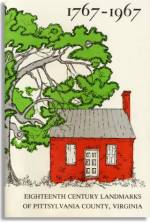
James Wesley Hearp (1845–1925)

James Wesley Hearp (1845–1925)
Strange men with pick and shovels moved into the Dry Fork community around 1905 and began to dig for gold on land leased to them by James “Jim” Wesley Hearp a local farmer and blacksmith. He also made tombstones and his handiwork can still be seen in many of the cemeteries in the neighborhood.
One of the gold mines was located on the east side of the W. I. Powell Road near Dixon Creek. For more than sixty years one could see mounds of earth that had been excavated by the miners as they searched for gold. As a boy I remember lstening to my father, Dewey Yeatts, and Oscar Stowe, a neighbor, talking about the gold mine. They said that they visited the mine often while gold was being mined since they lived a short distance from it. The shaft was more like a well going straight down with a windlass and a rope being wound around the axle to bring up the dirt to be inspected by men who appeared to know about gold. The dirt was brought to the top, carefully searched for gold, and piled up around the shaft. The mining effort brought workmen to the community and they boarded with the people who lived there. Two of the men who worked there boarded with Coleman and Susan Yeatts, whose farm adjoined the Hearp farm.

Lucy Ann Ricketts Hearp (1855–1948)
Another location of a mine was obvious due to the mound of earth left by the miners. The second mine was on the Charlie Price farm. The Emmanuel Pentecostal Holiness Church's parsonage was built on the land where the mine was located. According to the late Oscar Stowe who married one of Jim Welsey Hearp's daughters, the mine did not produce enough gold to make it profitable. There was a small amount of gold obtained by the effort but not enough to sustain a long time profitable business.
The mines were abandoned, the holes were left open, but little by little they were filled by debris. The children who lived nearby enjoyed playing on the mounts of earth, even with the warning of parents not to play around the mine due to the danger of falling into one of them.

Lucy and “German Jim” Hearp


Clement: History of Pittsylvania County

Fitzgerald: Pittsylvania: Homes and People of the Past

Hurt: Eighteenth Century Landmarks of Pittsylvania County

Hurt: An Intimate History of the American Revolution in Pittsylvania County

Dodson: Footprints from the Old Survey Books

Byrd: Histories of the Dividing Line Betwixt Virginia and North Carolina

Melton: Pittsylvania's Eighteenth-Century Grist Mills

Melton: Pittsylvania's Nineteenth-Century Grist Mills

Melton: Thirty-Nine Lashes, Well Laid On

Melton: Pittsylvania County's Historic Courthouse

Jones: Tales About People in a Small Town
This website is sponsored by Mitchells Publications.
Copyright © 1999 S. Dail Yeatts.